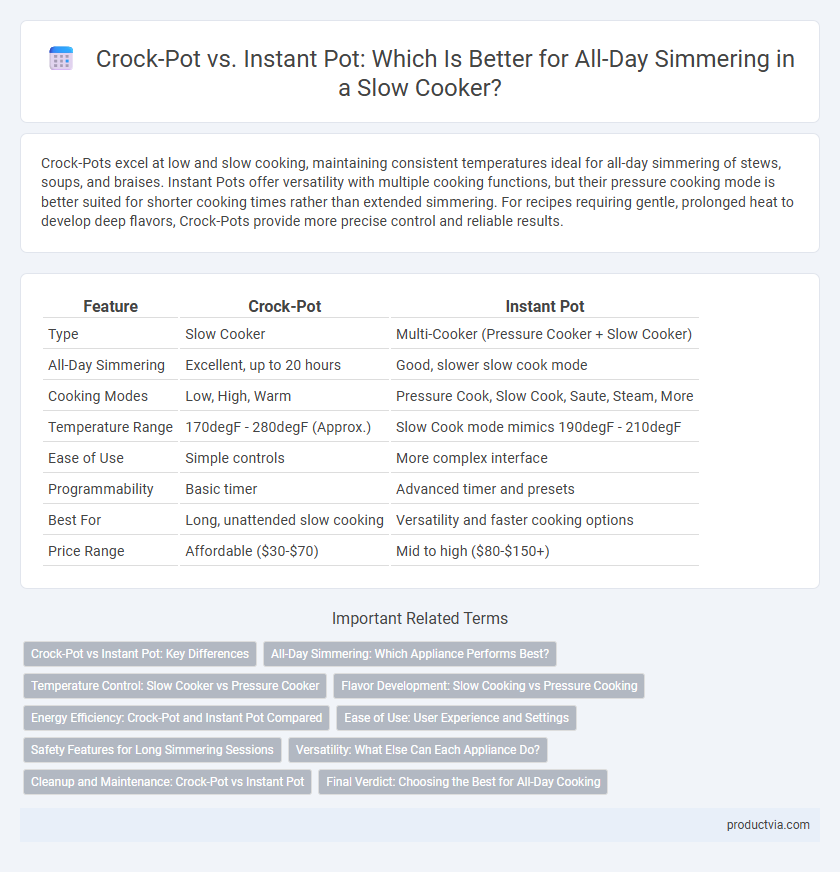Crock-Pots excel at low and slow cooking, maintaining consistent temperatures ideal for all-day simmering of stews, soups, and braises. Instant Pots offer versatility with multiple cooking functions, but their pressure cooking mode is better suited for shorter cooking times rather than extended simmering. For recipes requiring gentle, prolonged heat to develop deep flavors, Crock-Pots provide more precise control and reliable results.
Table of Comparison
| Feature | Crock-Pot | Instant Pot |
|---|---|---|
| Type | Slow Cooker | Multi-Cooker (Pressure Cooker + Slow Cooker) |
| All-Day Simmering | Excellent, up to 20 hours | Good, slower slow cook mode |
| Cooking Modes | Low, High, Warm | Pressure Cook, Slow Cook, Saute, Steam, More |
| Temperature Range | 170degF - 280degF (Approx.) | Slow Cook mode mimics 190degF - 210degF |
| Ease of Use | Simple controls | More complex interface |
| Programmability | Basic timer | Advanced timer and presets |
| Best For | Long, unattended slow cooking | Versatility and faster cooking options |
| Price Range | Affordable ($30-$70) | Mid to high ($80-$150+) |
Crock-Pot vs Instant Pot: Key Differences
Crock-Pot slow cookers provide consistent low-temperature cooking over extended periods, ideal for all-day simmering to develop deep flavors and tenderize tough cuts of meat, while Instant Pots offer multifunctional pressure cooking with faster results but less precise low-heat simmering. Crock-Pot models focus exclusively on slow cooking with simple controls and set-it-and-forget-it convenience, whereas Instant Pots combine slow cooking, pressure cooking, and sauteing, requiring more active management during the cooking process. For dishes needing gentle, prolonged simmering, Crock-Pot excels in maintaining steady heat without the risk of overcooking, distinguishing it from the Instant Pot's rapid cooking methods.
All-Day Simmering: Which Appliance Performs Best?
Crock-Pots excel at all-day simmering with consistent low heat and minimal temperature fluctuations, ideal for slow-cooked stews and soups. Instant Pots, while versatile with pressure cooking and saute functions, may not maintain gentle, long-duration simmering as precisely as Crock-Pots. For recipes requiring extended low-temperature cooking, Crock-Pots offer superior temperature control and energy efficiency.
Temperature Control: Slow Cooker vs Pressure Cooker
Crock-Pots offer precise low-temperature settings ideal for all-day simmering, maintaining steady heat between 170degF and 280degF to develop rich flavors over time. Instant Pots combine pressure cooking with slow cooking functions but may fluctuate in temperature due to pressure cycles, making them less consistent for gentle, prolonged simmering. For recipes requiring consistent low heat and gradual cooking, Crock-Pot slow cookers provide superior temperature control compared to the Instant Pot's pressure-based mechanisms.
Flavor Development: Slow Cooking vs Pressure Cooking
Slow cookers like the Crock-Pot excel at all-day simmering, allowing flavors to deepen and meld gradually, producing tender, richly infused dishes. Instant Pots use pressure cooking to drastically reduce cooking time, but this rapid process can sometimes limit the complexity of flavor development compared to slow simmering. For recipes requiring extended cooking, the Crock-Pot's gentle heat is superior for maximizing taste through prolonged flavor extraction.
Energy Efficiency: Crock-Pot and Instant Pot Compared
Crock-Pots use steady low heat throughout all-day simmering, typically consuming about 70 watts, making them highly energy-efficient for long cooking times. Instant Pots, while versatile with pressure cooking and multiple functions, can use 700 watts or more during operation but switch to lower wattage keep-warm mode afterward. For extended simmering, Crock-Pots maintain consistent low energy use, often resulting in lower overall electricity consumption compared to Instant Pots.
Ease of Use: User Experience and Settings
Crock-Pot offers a straightforward, classic slow cooking experience with simple, intuitive settings ideal for all-day simmering, requiring minimal user intervention. Instant Pot combines multifunctionality with programmable presets, but its complexity may overwhelm users seeking easy, hands-off simmering. For consistent ease of use in long simmering, Crock-Pot's dedicated slow cooker design provides a more user-friendly interface and predictable results.
Safety Features for Long Simmering Sessions
Crock-Pots are designed with built-in safety mechanisms such as automatic temperature regulation and insulated outer walls to prevent overheating during long all-day simmering sessions. Instant Pots incorporate advanced safety features including lid locking systems, pressure release valves, and overheat protection sensors to ensure secure cooking even when unattended for extended periods. Both appliances prioritize user safety but differ in their approach: Crock-Pots offer consistent low-temperature simmering, while Instant Pots combine pressure cooking safety with programmable slow cooking modes.
Versatility: What Else Can Each Appliance Do?
Crock-Pots excel at all-day simmering with reliable low-temperature cooking, perfect for stews and soups, while Instant Pots offer versatile functions including pressure cooking, sauteing, and yogurt making. The Instant Pot's multi-functionality allows meal prep efficiency beyond slow cooking, supporting faster recipes and diverse cooking techniques. Crock-Pots remain focused on slow, consistent simmering, whereas Instant Pots combine this with programmable options, expanding the appliance's overall usability in the kitchen.
Cleanup and Maintenance: Crock-Pot vs Instant Pot
Crock-Pots offer simple cleanup with removable, dishwasher-safe stoneware and lids that prevent food residue buildup during all-day simmering. Instant Pots, while versatile, require careful cleaning of the silicone sealing ring and steam valve to maintain optimal performance and avoid odors. Both appliances demand regular maintenance, but the Crock-Pot's fewer components generally result in easier, faster cleanup after extended cooking sessions.
Final Verdict: Choosing the Best for All-Day Cooking
Crock-Pot excels in all-day simmering with consistent low heat, making it ideal for slow-cooked stews and soups that require gentle, prolonged cooking. Instant Pot offers versatility with multiple cooking functions, but its pressure cooking feature is less suited for extended, low-temperature simmering compared to Crock-Pot's straightforward design. For dedicated all-day simmering, Crock-Pot remains the preferred choice due to its reliable temperature control and ease of use.
Crock-Pot vs Instant Pot for all-day simmering Infographic

 productvia.com
productvia.com